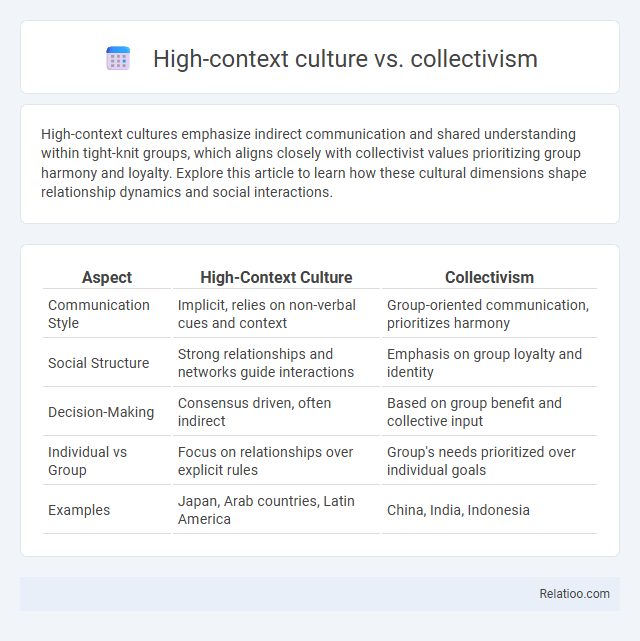High-context cultures emphasize indirect communication and shared understanding within tight-knit groups, which aligns closely with collectivist values prioritizing group harmony and loyalty. Explore this article to learn how these cultural dimensions shape relationship dynamics and social interactions.
Table of Comparison
| Aspect | High-Context Culture | Collectivism |
|---|---|---|
| Communication Style | Implicit, relies on non-verbal cues and context | Group-oriented communication, prioritizes harmony |
| Social Structure | Strong relationships and networks guide interactions | Emphasis on group loyalty and identity |
| Decision-Making | Consensus driven, often indirect | Based on group benefit and collective input |
| Individual vs Group | Focus on relationships over explicit rules | Group's needs prioritized over individual goals |
| Examples | Japan, Arab countries, Latin America | China, India, Indonesia |
Defining High-Context Culture
High-context culture emphasizes indirect communication, where much of the message is conveyed through context, nonverbal cues, and shared experiences rather than explicit words. It thrives in societies with strong relationships and mutual understanding, often overlapping with collectivist values that prioritize group harmony and social cohesion. This communication style contrasts with low-context cultures, where clarity and directness are paramount, reflecting differing approaches to social interaction and information exchange.
Understanding Collectivism
Understanding collectivism requires recognizing that it emphasizes group goals, social harmony, and interconnectedness, which closely aligns with the norms of high-context cultures where communication relies heavily on implicit messages and shared experiences. In such societies, your identity is strongly tied to family, community, and social networks, influencing behaviors and decision-making processes. This cultural framework fosters mutual support and cooperation, essential for maintaining group cohesion and collective well-being.
Key Differences Between High-Context Culture and Collectivism
High-context culture relies on implicit communication, where meaning is derived from context, non-verbal cues, and shared experiences, while collectivism emphasizes group loyalty and prioritizing community needs over individual desires. In high-context cultures, relationships and social harmony are maintained through nuanced interactions, whereas collectivism centers on mutual support and collective responsibility within the group. Your understanding of these key differences can improve cross-cultural communication and foster better collaboration in diverse environments.
Communication Styles in High-Context Societies
High-context cultures rely heavily on implicit communication, where nonverbal cues, context, and shared experiences convey meaning more than explicit words. In these societies, communication is often indirect, and understanding depends on reading between the lines, reducing the need for detailed explanations. Your ability to interpret subtle signals and maintain harmony is crucial for effective interaction in high-context, collectivist environments.
Group Dynamics in Collectivist Cultures
Collectivist cultures emphasize group harmony, shared goals, and strong interpersonal relationships, shaping high-context communication where nonverbal cues and implicit understanding are vital. Your interactions within these groups rely heavily on context, trust, and unwritten social norms that guide behavior and decision-making. This group-centric dynamic fosters cooperation and loyalty but can challenge outsiders unfamiliar with subtle cultural signals.
The Role of Relationships in High-Context Environments
In high-context cultures, relationships carry significant weight as communication relies heavily on shared experiences and implicit understanding, making personal connections essential for effective interaction. Collectivism emphasizes group harmony and interdependence, reinforcing the need for maintaining strong relationships to support social cohesion and mutual obligations. The role of relationships in high-context environments is pivotal, as trust, loyalty, and long-term commitments guide communication and decision-making processes.
Loyalty and Group Identity in Collectivist Societies
In collectivist societies, loyalty to the group and strong group identity are fundamental, shaping social behaviors and decision-making processes. High-context cultures rely heavily on implicit communication, shared experiences, and non-verbal cues, reinforcing group cohesion and trust within the community. Your understanding of these dynamics enhances effective interaction and fosters deeper relationships in environments where group loyalty and context-driven communication prevail.
Overlapping Features: Similarities and Contrasts
High-context culture and collectivism both emphasize strong group cohesion, indirect communication, and reliance on shared knowledge to convey meaning, fostering deep interpersonal relationships and community orientation. While high-context cultures prioritize non-verbal cues and context in communication, collectivism centers on group goals and social harmony, often reinforcing high-context communication through collective norms. The overlap lies in their mutual focus on interconnectedness and implicit understanding, yet high-context culture primarily addresses communication styles, whereas collectivism encompasses broader social and cultural values.
Impacts on Business and Workplace Interaction
High-context cultures prioritize implicit communication, relying on shared experiences and nonverbal cues, which can enhance trust and long-term relationship building in business but may cause misunderstandings with outsiders. Collectivism emphasizes group harmony and consensus, fostering teamwork and loyalty but sometimes hindering individual initiative and decision-making speed in the workplace. Combining high-context culture with collectivism intensifies the reliance on subtle communication and group cohesion, requiring businesses to adapt strategies that respect indirect messaging and collective values for effective collaboration.
Navigating Cross-Cultural Misunderstandings
Navigating cross-cultural misunderstandings requires understanding the nuances between high-context culture and collectivism, as both emphasize social harmony but differ in communication styles and group dynamics. High-context cultures rely heavily on implicit communication and shared experiences, whereas collectivist cultures prioritize group goals and interdependence, which may affect how messages are interpreted. Your ability to recognize these distinctions can reduce misinterpretations and foster more effective interactions in diverse cultural settings.

Infographic: High-context culture vs Collectivism
 relatioo.com
relatioo.com